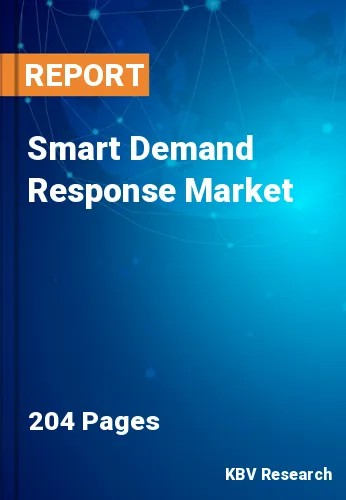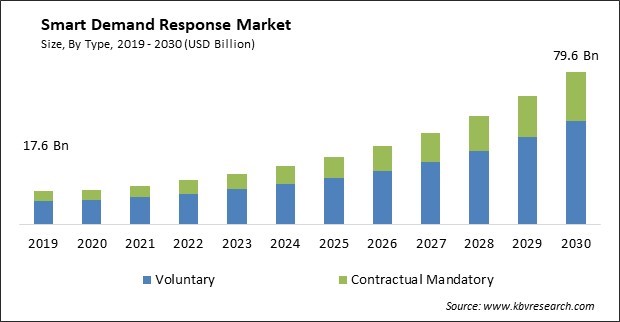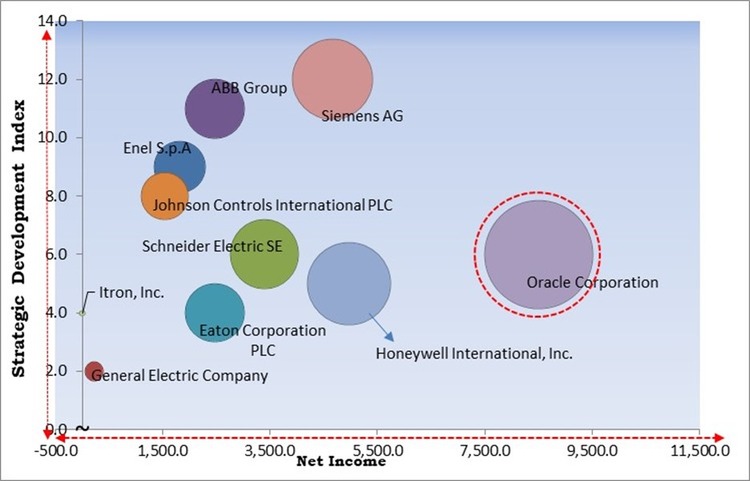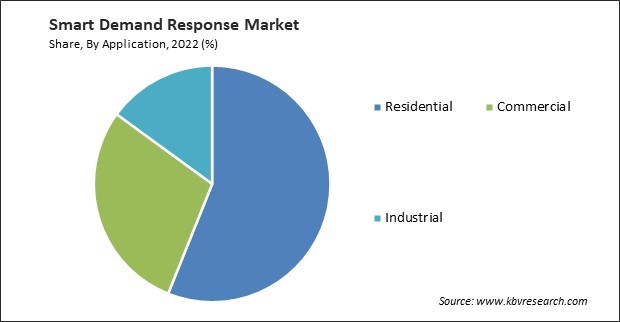
The Global Smart Demand Response Market size is expected to reach $79.6 billion by 2030, rising at a market growth of 17.1% CAGR during the forecast period.
A robust economy, characterized by rising GDP, increasing consumer spending, and low unemployment, creates favorable conditions for commercial expansion. Consequently, the commercial segment captured $5.2 Billion revenue in the market in 2020. As individuals and businesses experience improved financial stability, they are more willing to invest, expand, and consume goods and services. Adequate infrastructure, including transportation, energy, and communication networks, is essential for businesses to expand. Regions with well-developed infrastructure can attract commercial investment and growth. High-speed internet and digital connectivity are also crucial in the modern business environment.

The major strategies followed by the market participants are Partnerships as the key developmental strategy to keep pace with the changing demands of end users. For instance, In April, 2023, Enel S.p.A signed a partnership with Phoenix Energy Technologies. The partnership would allow Enel to serve its customers with complex energy systems. Moreover, In February, 2023, Siemens AG signed a partnership with EnergyHub, to provide utilities with next-generation DER management solutions. The two companies would achieve the aim by combining each other's network expertise and grid-edge capabilities.
Based on the Analysis presented in the KBV Cardinal matrix; Oracle Corporation is the forerunner in the Market. Companies such as Honeywell International, Inc., Siemens AG, Schneider Electric SE are some of the key innovators in Market. For Instance, In June, 2021, Schneider Electric SE came into partnership with SolarX, to deploy microgrids in Francophone Africa. The partnership would enable Schneider Electric to expand its footprint in Africa.

Automation, artificial intelligence, and the Internet of Things (IoT) have transformed manufacturing and production processes in the industrial sector. These advancements improve efficiency and open up new possibilities for product development and customization, thereby driving growth. A growing global economy leads to increased consumer demand for products and services. As consumer spending rises, industrial sectors catering to these demands, such as consumer goods, automotive, and electronics, experience expansion. Economic growth is a significant driver for industrial sector growth. As the industrial and commercial sectors expand, governments and regulatory bodies often introduce policies and incentives to encourage participation in DR programs. This support can include financial incentives, energy efficiency targets, and simplified participation processes. Expanding the industrial and commercial sectors substantially and positively impacts the market. As these sectors continue to grow, the market will witness growth.
As energy costs rise, consumers and businesses are motivated to find ways to reduce their electricity bills. Its programs offer a solution to mitigate these rising costs by enabling them to adjust their energy consumption during peak pricing periods. Participants can achieve significant savings by reducing energy use when prices are high. Rising energy costs have created a financial incentive for consumers and businesses to participate in DR programs actively. Many utilities and grid operators offer financial incentives, such as bill credits or reduced rates, to those who curtail their energy usage during peak demand hours. Consumers and businesses are increasingly informed about the environmental and economic benefits of participating in DR programs, leading to greater participation. The expansion of the market can be attributed mainly to the financial incentives and cost-saving opportunities it provides in response to rising energy costs.
DERs, such as solar panels and wind turbines, are often intermittent and variable energy sources. This makes it challenging to predict energy availability accurately, which is critical for effective demand response planning and grid balancing. DERs, including energy storage systems and electric vehicles, allow two-way energy flow between consumers and the grid. This bi-directional flow can complicate demand response strategies and coordination. While energy storage can enhance the flexibility of DERs, it can also pose challenges when predicting and managing energy use. The interaction between energy storage and demand response needs careful planning. This congestion can limit the grid's ability to accommodate additional distributed energy generation and storage. With the growing DERs in the industry, it is expected to decline the market growth in the coming years.
On the basis of application, the market is segmented into residential, commercial, and industrial. In 2022, the residential segment dominated the market with the maximum revenue share. There is a growing need to improve energy efficiency and reduce carbon emissions in residential buildings. For residential customers, demand response (DR) programs entail direct load control of the larger appliances at home, which includes water heaters, pool pumps, and air conditioning systems. Smart buildings are expected to participate in DR programs to protect the electrical grid during high peak energy demand. Reducing loads during high-cost periods is expected to reduce electricity bills, proving advantageous to consumers.

Based on type, the market is fragmented into voluntary and contractual mandatory. The contractual mandatory segment recorded a remarkable revenue share in the market in 2022. Contractual mandatory DR can reduce environmental impact by encouraging participants to reduce their energy consumption during peak periods when fossil fuels are often used to meet increased electricity demand. Contractual mandatory its programs typically target sectors or consumers where grid reliability and stability are critical. While these programs can effectively address grid challenges, they require careful planning, communication, and coordination between program administrators and participants to ensure successful compliance.
| Report Attribute | Details |
|---|---|
| Market size value in 2022 | USD 23 Billion |
| Market size forecast in 2030 | USD 79.6 Billion |
| Base Year | 2022 |
| Historical Period | 2019 to 2021 |
| Forecast Period | 2023 to 2030 |
| Revenue Growth Rate | CAGR of 17.1% from 2023 to 2030 |
| Number of Pages | 204 |
| Number of Table | 253 |
| Report coverage | Market Trends, Revenue Estimation and Forecast, Segmentation Analysis, Regional and Country Breakdown, Competitive Landscape, Companies Strategic Developments, Company Profiling |
| Segments covered | Type, Application, Region |
| Country scope | US, Canada, Mexico, Germany, UK, France, Russia, Spain, Italy, China, Japan, India, South Korea, Singapore, Malaysia, Brazil, Argentina, UAE, Saudi Arabia, South Africa, Nigeria |
| Growth Drivers |
|
| Restraints |
|
Region-wise, the market is analysed across North America, Europe, Asia Pacific, and LAMEA. In 2022, the North America region held the highest revenue share in the market. There is a growing need to manage electricity demand and address peak load challenges. As energy consumption rises, utilities seek innovative solutions to balance supply and demand, reduce strain on the grid, and avoid potential blackouts or disruptions. In California, buildings are foreseen to contribute to the highest peak load. The Demand Response Research Center (DRRC) focuses on commercial and residential applications of technologies for dynamic peak load reduction with different response durations.
Free Valuable Insights: Global Smart Demand Response Market size to reach USD 79.6 Billion by 2030
The market research report covers the analysis of key stake holders of the market. Key companies profiled in the report include ABB Group, Eaton Corporation PLC, Enel S.p.A, General Electric Company, Honeywell International, Inc., Johnson Controls International PLC, Oracle Corporation, Siemens AG, Schneider Electric SE and Itron, Inc.
By Type
By Application
By Geography
This Market size is expected to reach $79.6 billion by 2030.
Growing industrial and commercial industry are driving the Market in coming years, however, Increasing Adoption of Distributed Energy Resources (DERS) restraints the growth of the Market.
ABB Group, Eaton Corporation PLC, Enel S.p.A, General Electric Company, Honeywell International, Inc., Johnson Controls International PLC, Oracle Corporation, Siemens AG, Schneider Electric SE and Itron, Inc.
The expected CAGR of this Market is 17.1% from 2023 to 2030.
The Voluntary segment is leading the the Market, by Type in 2022, thereby, achieving a market value of $53.8 Billion by 2030.
The North America region dominated the Market, by Region in 2022, and would continue to be a dominant market till 2030; thereby, achieving a market value of $29 Billion by 2030.
Our team of dedicated experts can provide you with attractive expansion opportunities for your business.
